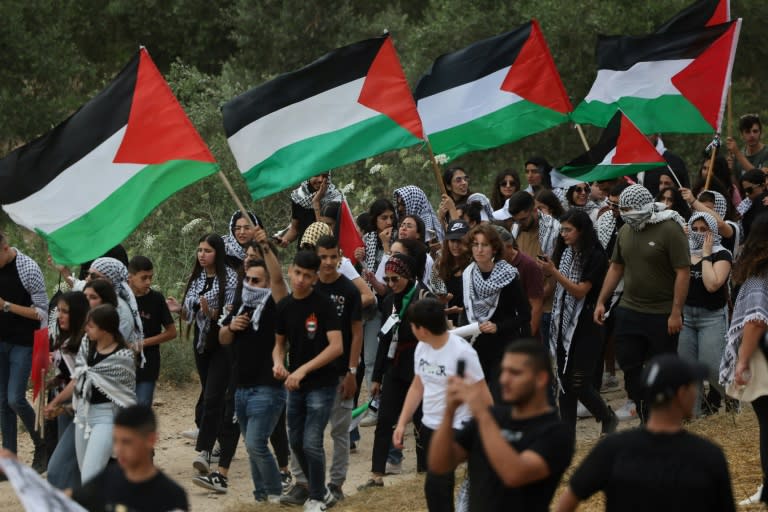Palestinians rally at historic villages in northern Israel

Thousands of people took part Tuesday in an annual march through the ruins of villages that Palestinians were expelled from during the 1948 war that led to Israel's creation.
Wrapped in keffiyeh scarves and waving Palestinian flags, men and women rallied through the abandoned villages of Al-Kassayer and Al-Husha -- many holding signs with the names of dozens of other demolished villages their families were displaced from.
"Your Independence Day is our catastrophe," reads the rallying slogan for the protest that took place as Israelis celebrated the 76th anniversary of the proclamation of the State of Israel.
The protest this year was taking place against the backdrop of the ongoing war in Gaza, where fighting between Israel and Palestinian militant group Hamas has displaced the majority of the population, according to the United Nations.
Among those marching Tuesday was 88-year-old Abdul Rahman al-Sabah.
He described how members of the Haganah, a Zionist paramilitary group, forced his family out of Al-Kassayer, near the northern city of Haifa, when he was a child.
They "blew up our village, Al-Kassayer, and the village of Al-Husha so that we would not return to them, and they planted mines," he said, his eyes glistening with tears.
The family was displaced to the nearby town of Shefa-Amr.
"But we continued (going back), my mother and I, and groups from the village, because it was harvest season, and we wanted to live and eat," he said.
"We had nothing, and whoever was caught by the Israelis was imprisoned."
Palestinians remember this as the "Nakba", or catastrophe, when around 760,000 Palestinians fled or were driven from their homes during the war that led to the creation of Israel.
The descendants of the 160,000 Palestinians who managed to remain in what became Israel presently number about 1.4 million, around 20 percent of Israel's population.
- 'We will remain'-
Many of today's Arab Israelis remain deeply connected to their historic land.
At Tuesday's march, one man carried a small sign with "Lubya", the name of what was once a Palestinian village near Tiberias.
Like many other Palestinian villages, Al-Husha and Al-Kassayer witnessed fierce battles in mid-April 1948, according to historians of the Haganah, among the Jewish armed groups that formed the core of what became the Israeli military.
Today, the kibbutz communities of Osha, Ramat Yohanan and Kfar Hamakabi can be found on parts of land that once housed the two villages.
"During the attack on our village Al-Husha, my father took my mother, and they rode a horse to the city of Shefa-Amr," said Musa al-Saghir, 75, whose village had been largely made up of people who immigrated from Algeria in the 1880s.
"When they returned to see the house, the Haganah forces had blown up the village and its houses," said the activist from a group advocating for the right of return for displaced Arabs.
Naila Awad, 50, from the village of Reineh near Nazareth, explained that the activists were demanding both the return of displaced people to their demolished villages within Israel, as well as the return of the millions of Palestinian refugees living in the West Bank, Gaza and other countries.
"No matter how much you try to break us and arrest us, we will remain on our lands," she insisted.
mab-ysm/nl/dv

